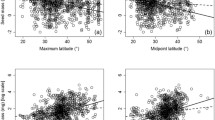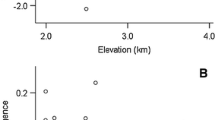Abstract
Seed shape and seed volume are functionally important traits which are associated with seed germination. To study the ecological and evolutionary significance of seed shape and volume in relation to germination, a database comprising seed information for 383 species within 50 families from an alpine meadow on the eastern Qinghai-Tibet plateau was compiled. The independent and interactive effects of seed traits on germination and whether these effects are controlled by phylogeny are discussed. The results show the following: (1) Elongated seeds had higher percentage and faster speed of germination than compact seeds whereas smaller seeds tended to have higher germinability compared to larger ones; (2) Seed volume and shape evolved together but had independent effects on seed germination. Seed volume had no significant influence on seed germination among species with compact seeds, but had a significant effect on those among species with elongated seeds; seed germination of larger seeded species was affected by seed shape, but not by seed volume. These results might be related to their predation pressure and ability to germinate from deeper soil layers. Lastly, (3) Phylogenetic conservation plays an important role in the co-evolution of seed traits and germination characteristics. Species with similarly shaped seeds on a large scale might reflect a common selective pressure, but related species within a family might be more dependent on phylogenetic conservation.

Similar content being viewed by others
References
Bekker RM, Bakker JP, Grandin U, Kalamees R, Milberg P, Poschlod P, et al. (1998) Seed size, shape and vertical distribution in the soil: indicators of seed longevity. Funct Ecol 12:834–842
Blate GM, Peart DR, Leighton M (1998) Post-dispersal predation on isolated seeds: a comparative study of 40 tree species in a Southeast Asian rainforest. Oikos 82:522–538
Bu H, Du G, Chen X, Xu X, Liu K, Wen S (2008) Community-wide germination strategies in an alpine meadow on the eastern Qinghai-Tibet plateau: phylogenetic and life-history correlates. Pl Ecol 195:87–98
Burke MJ, Grime JP (1996) An experimental study of plant community invisibility. Ecology 77:776–790
Counts RL, Lee PF (1991) Germination and early seedling growth in some northern wild rice (Zizania palustris) populations differing in seed size. Canad J Bot 69:689–696
R Development Core Team (2016) R: A language and environment for statistical computing. R Foundation for Statistical Computing, Vienna
Du G, Qi W (2010) Trade-offs between flowering time, plant height, and seed size within and across 11 communities of a QingHai-Tibetan flora. Pl Ecol 209:321–333
Easton LC, Kleindorfer S (2008) Interaction effects of seed mass and temperature on germination in Australian species of Frankenia (Frankeniaceae). Folia Geobot 43:383–396
Eriksson O (1999) Seed size variation and its effect on germination and seedling performance in the clonal herb Convallaria majalis. Acta Oecol 20:61–66
Felsenstein J (1985) Phylogenies and the comparative method. Amer Naturalist 125:1–15
Fenner M (1983) Relationships between seed weight, ash content and seedling growth in twenty-four species of Compositae. New Phytol 95:697–706
Foster S, Janson CH (1985) The relationship between seed size and establishment conditions in tropical woody plants. Ecology 66:773–780
Grime JP (1989) Seed banks in ecological perspective. In Leck MA, Parker VT, Simpson RL (eds) Ecology of soil seed banks. Academic Press, London, pp 15–22
Grime JP, Mason G, Curtis AV, Rodman J, Band SR, Mowforth M, et al. (1981) A comparative study of germination characteristics in a local flora. J Ecol 69:1017–1059
Grime JP, Hodgson JG, Hunt R (1988) Comparative plant ecology: a functional approach to common British species. Unwin-Hyman, London
Grubb PJ, Burslem DFRP (1998) Mineral nutrient concentrations as a function of seed size within seed crop: implications for a competition among seedlings and defence against herbivory. J Trop Ecol 14:177–185
Grubb PJ, Coomes DA (1997) Seed mass and nutrient content in nutrient-starved tropical rainforest in Venezuela. Seed Sci Res 7:269–280
Harper JL, Lovell PH, Moore KG (1970) The shapes and size of seeds. Annual Rev Ecol Syst 1:327–356
Hendrix SD (1984) Variation in seed weight and its effects on germination in Pastinaca sativa L. (Umbelliferae). Amer J Bot 71:795–802
Hutchings MJ, Booth KD (1996) Studies on the feasibility of re-creating chalk grassland vegetation on ex-arable land. I. The potential roles of the seed bank and the seed rain. J Appl Ecol 33:1171–1181
Janzen DH (1971) Seed predation by animals. Annual Rev Ecol Evol Syst 2:465–492
Jiménez-Alfaro B, Silveira FAO, Fidelis, Poschlod P, Commander LE (2016) Seed germination traits can contribute better to plant community ecology. J Veg Sci 27:637–645
Jurado E, Westoby M (1992) Germination biology of selected central Australian plants. Austral J Ecol 17:341–348
Khan ML, Uma Shankar (2011) Effect of seed weight, light regime, and substratum microsite on germination and seedling growth of Quercus semiserrata Roxb. Trop Ecol 42:117–125
Kos M, Poschlod P (2010) Why wait? Trait and habitat correlates of variation in germination speed among Kalahari annuals. Oecologia 162:549–559
Kumar R, Shamet GS, Alam NM, Jana C (2016) Influence of growing medium and seed size on germination and seedling growth of Pinus gerardiana Wall. Compost Sci Utiliz 24:98–104
Leishman MR, Westoby M, Jurado E (1995) Correlates of seed size variation: a comparison among five temperate floras. J Ecol 83:517–530
Lord J, Westoby M, Leishman MR (1995) Seed size and phylogeny in six temperate floras: constraints, niche conservatism, and adaptation. Amer Naturalist 146:349–364
Louda SM (1989) Predation in the dynamics of seed regeneration. In Leck MA, Parker VT, Simpson RL (eds) Ecology of soil seed banks. Academic Press, New York, pp 25–51
Mckersie BD, Tomes DT, Yamamoto S (1981) Effect of seed size on germination, seedling vigor, electrolyte, and establishment of bird’s-foot trefoil. Canad J Plant Sci 61:337–343
Meyer SE, Carlson SL (2001) Achene mass variation in Ericameria nauseosus (Asteraceae) in relation to dispersal ability and seedling fitness. Funct Ecol 15:274–281
Pagel M (1999) Inferring the historical patterns of biological evolution. Nature 401:877–884.
Pearson TRH, Burslem DFRP, Mullins CE, Dalling JW (2002) Germination ecology of Neotropical pioneers: interacting effects of environmental conditions and seed size. Ecology 83:2798–2807
Piper JK (1986) Germination and growth of bird-dispersed plant effects of seed size and light on seedling vigor and biomass allocation. Amer J Bot 73:959–965
Rees M (1993) Trade-offs among dispersal strategies in British plants. Nature 366:150–152
Rees M (1994) Dealyed germination of seeds: a look at the effects of adult longevity, the timing of the reproduction, and population age/stage structure. Amer Naturalist 144:43–64
Reynolds C, Cumming GS (2016) Seed traits and bird species influence the dispersal parameters of wetland plants. Freshwater Biol 61:1157–1170
The Angiosperm Phylogeny Group (2009) An update of the Angiosperm Phylogeny Group classification for the orders and families of flowering plants: APG III. Bot J Linnean Soc 161:105–121
Thompson K (1987) Seeds and seed banks. New Phytol 106(suppl.):23–24
Thompson K, Grime JP (1979) Seasonal variation in the seed banks of herbaceous species in ten contrasting habitats. J Ecol 67:893–921
Thompson K, Band SR, Hodgson JG (1993) Seed size and shape predict persistence in soil. Funct Ecol 7:236–241
Tripathi RS, Khan ML (1990) Effects of seed weight and microsite characteristics on germination and seedling fitness in two species of Quercus in a subtropical wet hill forest. Oikos 57:289–296
Vázquez-Yanes CA, Orozco-Segovia ER, Rincón M, Sanchez-Coronado ME, Huante R, Toledo JR, Barradas UL (1990) Light beneath the litter in a tropical forest: effect on seed germination. Ecology 71:1952–1958
Venable DL, Brown JS (1988) The selective interactions of dispersal, dormancy, and seed size as adaptations for reducing risk in variable environments. Amer Naturalist 131:360–384
Vera ML (1997) Effects of altitude and seed size on germination and seedling survival of heathland plants in north Spain. Pl Ecol 133:101–106
Webb CO, Ackerly DD, Kembel SW (2008) Phylocom: software for the analysis of phylogenetic community structure and trait evolution. Bioinformatics 24:2098–2100
Winn AA (1988) Ecological and evolutionary consequences of seed size in Prunella vulgaris. Ecology 69:1537–1544
Wullf RD (1986) Seed size variation in Desmodium paniculatum. II. Effects on seedling growth and physiological performance. J Ecol 74:99–114
Zheng Y, Xie Z, Gao Y, Shimizu H, Jiang L, Yu Y (2003) Ecological restoration in northern China: germination characteristics of nine key species in relation to air seeding. Belg J Bot 136:129–13
Acknowledgements
Thanks Dr James Lawson for correcting English spelling and grammar. Thanks Dr Peng Jia for helping to analyse phylogenetic signal of seed traits. This study has been supported by the Nature Science Fund of China (41171046, 31600329, 31670437) and the Fundamental Research Funds for the Central Universities (lzujbky-2016-92).
Author information
Authors and Affiliations
Corresponding author
Additional information
Hai-Yan Bu and Xue-Jing Wang contributed equally to this work.
Electronic Supplementary Material
Rights and permissions
About this article
Cite this article
Bu, HY., Wang, XJ., Zhou, XH. et al. The ecological and evolutionary significance of seed shape and volume for the germination of 383 species on the eastern Qinghai-Tibet plateau. Folia Geobot 51, 333–341 (2016). https://doi.org/10.1007/s12224-016-9271-y
Received:
Accepted:
Published:
Issue Date:
DOI: https://doi.org/10.1007/s12224-016-9271-y




